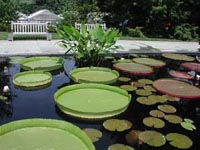Resource Library
Plant of the Week: Waterlily, Victoria
The University of Arkansas System Division of Agriculture does not promote, support or recommend plants featured in "Plant of the Week." Please consult your local Extension office for plants suitable for your region.
Plant of the Week
Victoria Waterlily
Latin: Victoria sp.

I have always found the back story about plants, with their interconnecting strands of linkages, intriguing and useful as a guide for understanding why things are the way they are. Many connections are tenuous, but not so with the connection between the Victoria waterlily and the Seattle World Fair.
Victoria waterlilies are from tropical areas of South America. Victoria amazonica is found in the tributaries of the Amazon where it grows in warmer, deeper waters as a short lived perennial. The floating, usually purple-tinged leaves are as much as 6 feet across with upturned edges 2 or 3 inches high.
Leaf petioles and midribs are hollow and armed with razor sharp spines that produce a compound that prevents blood from coagulating. This is not a good thing when you realize pirana inhabit these same waters.
The other species, V. cruziana, occurs farther inland in areas prone to summer dry spells, so it often grows an annual. Its leaves are usually a medium green, about 4 feet across with upturned edges 4 or 5 inches high. Victoria leaves are extremely buoyant and capable of supporting the weight of a full grown man.
Victoria waterlilies produce dinner plate-size blooms that open at night. On the first night flowers are white, the second they turn to various shades of pink or purple. They third day they are pulled below the surface to await the maturation of the seeds.
These tropical beauties were first seen by European explorers in 1801, but the first published account using the name Victoria did not appear until 1837 when John Lindley, a famous English botanist, named the plant for Queen Victoria. Attempts to grow it indoors were fruitless until 1849, when it was realized that the water temperature had to be above 80 degrees for them to grow. The Victoria waterlilies at Shaw's Garden in St. Louis (Missouri Botanic Garden) trace their linage back to these first plants at Kew. The gardener in charge of the plants, James Gurney, was later hired by Mr. Shaw and brought to St. Louis.

The 1840s were an era where interest in gardening and horticulture exploded. Tropical plants were especially prized and the rich and famous gentry of the day were busy trying to outdo one another with elaborate "stove houses" (ie, greenhouses). This was all made possible because of the rapid expansion of two new technologies - the newly perfected techniques for casting iron into ornate shapes and the mass production of glass.
Trade shows showcasing the products of an industry are commonplace today. They date back to the late 1700s in England and France, but were mostly focused on showcasing products from the country hosting the exhibition. The first international trade show (what we now think of as a World Fair), dates to the Great Exhibition of 1851 in England. This show, with its over-the-top designs, set the standards for the Victorian era and has served as a model of grandeur for Worlds Fairs ever since.
The centerpiece of the exhibition was to be an enormous glass greenhouse, later called "Crystal Palace" and built in what is now Hyde Park, just outside Old London. Joseph Paxton (1803-1865), a gardener and defacto greenhouse engineer, won the competition for the design. His concept of crowning the boxy nave of the greenhouse with an arched roof was inspired and, in large measure, copied from the vein pattern on the underside of the Victoria waterlily leaf. That same pattern is often seen mirrored in many stained glass windows of old churches.
The three story greenhouse was audacious with a footprint of over 22 acres. It contained 293,655 panes of glass that were supported by 330 huge iron columns. The structure was finally removed at the beginning of WWII, partly to recycle the steel for the war effort.
Growing Victoria waterlilies is considered an art form and water gardeners consider them the most difficult group to grow. They are only cultivated from seed which is available from commercial growers.
By: Gerald Klingaman, retired
Extension Horticulturist - Ornamentals
Extension News - August 12, 2005
The University of Arkansas System Division of Agriculture does not maintain lists of retail outlets where these plants can be purchased. Please check your local nursery or other retail outlets to ask about the availability of these plants for your growing area.